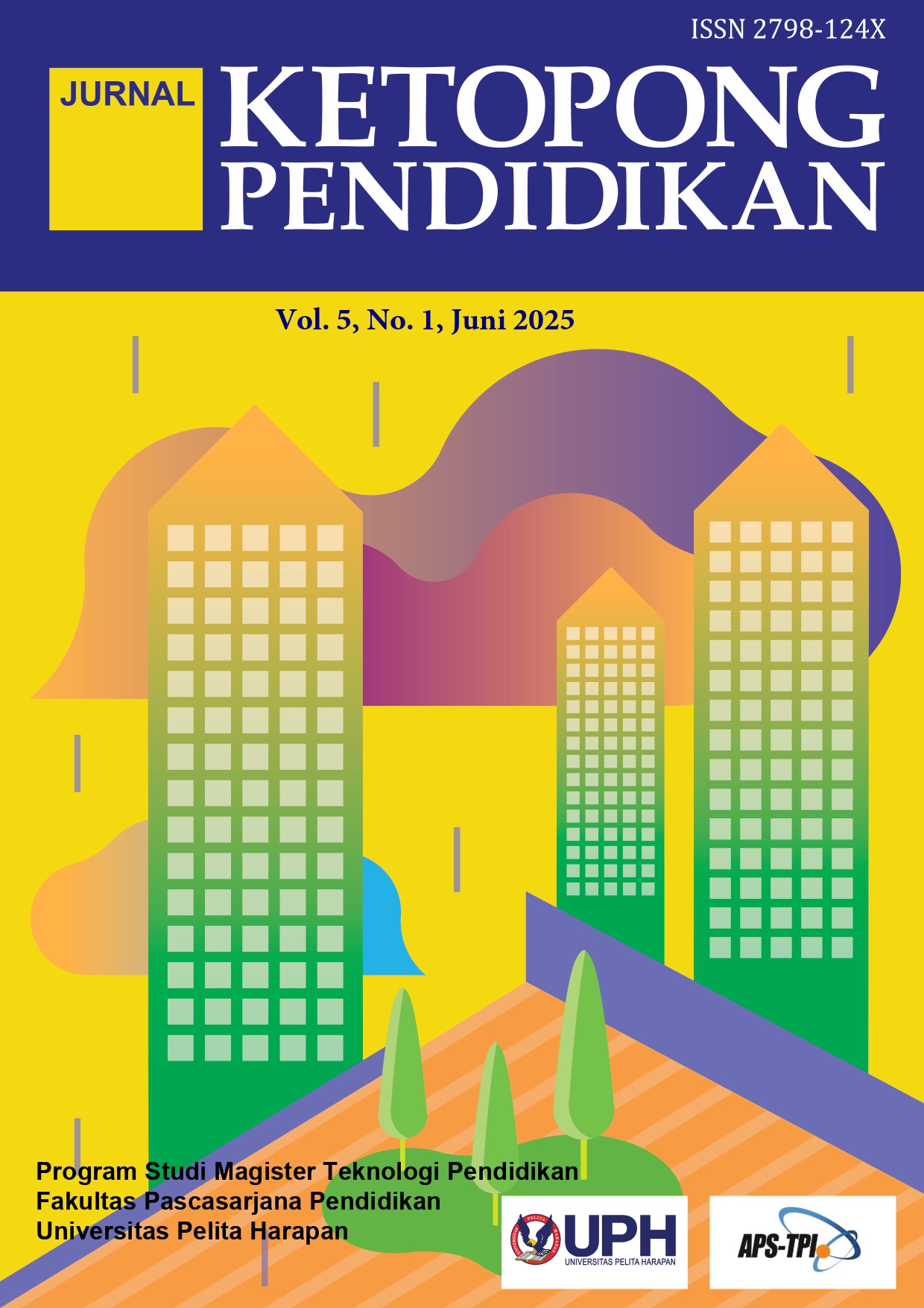Screen Time pada Pembelajaran Daring untuk Anak Usia Dini: Sejauh Mana Dampaknya? [Screen Time in Online Learning for Early Childhood: What Impact Does It Have?]
DOI:
https://doi.org/10.19166/jkp.v1i1.7723Schlagworte:
Online Learning, Screen Time, Early Childhood , [Pembelajaran Daring, Durasi Menatap Layar, Anak usia dini]Abstract
The current rapid development of science and technology and the limitations of face-to-face learning during the Covid 19 pandemic, have required online learning. This affects the length of screen time, especially in the early childhood stages. The impact of online learning and increased screen time in early childhood needs to be investigated to become a reference for learning methods and strategies for both teachers and parents. This study was conducted by comparing some of the literature on online learning and screen time in early childhood. This study shows that the positive impact of online learning is that it allows children to be able to learn from anywhere and at any time, increases the time and cost efficiency, and allows children to have a wealth of unique learning experiences. While the negative impacts are the uneven quality of internet connections, especially in remote areas, limited access to learning tools to support online learning processes, limited digital skills of children and teachers, and limited interaction between teachers and children. The side effects of excessive amounts of screen time in early childhood can be detrimental to physical and mental health, causing speech delays, and limiting opportunities to develop social skills.
Literaturhinweise
American Academy of Child and Adolescent Psychiatry. (2020, June 23). Screen time and children. American Academy of Child and Adolescent Psychiatry. https://www.aacap.org/AACAP/Families_and_Youth/Facts_for_Families/FFF-Guide/Children-And-Watching-TV-054.aspx
Anggreani, C. (2022). Pembelajaran daring pada masa pandemi COVID-19 di pendidikan anak usia dini. Edukatif: Jurnal Ilmu Pendidikan, 4(2), 1897–1907. https://doi.org/10.31004/edukatif.v4i2.2346
Arianto, F., Bachri, B. S., & Mariono, A. (2022). Asynchronous dan synchronous learning pada Pendidikan Tinggi: Studi komparasi. Jurnal Ilmiah Mandala Education, 8(4), 3008–30012. http://dx.doi.org/10.58258/jime.v8i4.4067
Arifah, R. B., & Maknun, L. (2024). Pengaruh gadget terhadap perkembangan anak usia dini. Multidisciplinary Indonesian Center Journal, 1(4), 1870–1875. https://doi.org/10.62567/micjo.v1i4.264
Arumugam, C. T., Said, M. A., Farid, N. D. N., & Rizal, H. (2022). Screen time influence on early childhood social-emotional development. Health Problems of Civilization, 16(3), 190–198. http://dx.doi.org/10.5114/hpc.2022.118754
Chaeruman, U. A. (2018). PEDATI model desain sistem pembelajaran blended. Universitas Negeri Jakarta.
Diasti, K. (2021). Faktor-faktor pendukung dan penghambat belajar dalam jaringan (DARING). Jurnal Pendidikan Islam Al-Affan, 1(2), 151–162. https://doi.org/10.69775/jpia.v1i2.26
Fajariyah, S. N., Suryawan,, A., & Atika, A. (2018). Dampak penggunaan gawai terhadap perkembangan anak. Sari Pediatri, 20(2), 101–105. https://dx.doi.org/10.14238/sp20.2.2018.101-5
Ferri, F., Grifoni, P., & Guzzo, T. (2020). Online learning and emergency remote teaching: Opportunities and challenges in emergency situations. Societies, 10(4), 1–18. https://doi.org/10.3390/soc10040086
Ginting, S. (2020). Kajian pembelajaran daring bagi pendidikan anak usia dini. E-Prosiding Pascasarjana Universitas Negeri Gorontalo, 97–100. https://ejurnal.pps.ung.ac.id/index.php/PSI/article/view/354
Hafina, A. (2021). Karakteristik perkembangan anak usia dini. Universitas Pendidikan Indonesia.
Hakim, M. F. A. (2022). Tantangan dan solusi pembelajaran online berbasis digital pada masa pandemic COVID-19 Tarikhuna. Journal of History and History Education, 4(1), 44–56 http://dx.doi.org/10.15548/thje.v4i1.4249
Kellough, R. D. (2006). A resource guide for teaching K-12 (5th ed.). Prentice Hall.
Kementerian Kesehatan Republik Indonesia. (2021, September 21). Pandemi COVID-19 ini membuat screen time pada anak meningkat, apa itu. Direktorat P2PTM. https://kemkes.go.id/id/home
Klimenskikh, M. V., Lebedeva, J. V., Maltsev, A. V., & Savelyev, V. V. (2019). Psychological factors of online-learning efficiency of students. International Scientific Electronic Journal, 42(6), 312–321. https://dx.doi.org/10.32744/pse.2019.6.26
Konca, A. S. (2021). Digital technology usage of young children: Screen time and families. Early Childhood Education Journal, 50, 1097–1108. https://doi.org/10.1007/S10643-021-01245-7
Manongga, K. A., Kasenda, V., & Monintja, D. K. (2021). Kebijakan pemerintah daerah dalam penerapan pembelajaran daring di Kabupaten Kepulauan Talaud. Governance, 1(2), 1–9. https://ejournal.unsrat.ac.id/v3/index.php/governance/article/view/36335
Masmali, A., & Alghamdi, F. (2021). Factors influencing teachers’ continuation of online learning in elementary schools. International Education Studies, 14(12), 31–39. http://dx.doi.org/10.5539/ies.v14n12p31
Moore, J. L., Dickson-Deane, C., & Galyen, K. (2011). E-learning, online learning, and distance learning environments: Are they the same? The Internet and Higher Education, 14(2), 129–135. http://dx.doi.org/10.1016/j.iheduc.2010.10.001
Musa, H., Rashid, A. A., Sadik, S. F. M., Goh, J. X., Kesavan, G. V., & Nurdiyana, N. (2022). Factors associated with excessive screen time usage among preschool children and risk for behavior problems. Malaysian Journal of Paediatrics and Child Health, 28(2), 13–25. https://doi.org/10.51407/mjpch.v28i2.183
Mustonen, R., Torppa, R., & Stolt, S. (2022). Screen time of preschool-aged children and their mothers, and children’s language development. Children, 9(10), 1–13. https://doi.org/10.3390/children9101577
National Association for the Education of Young Children. (2020, April 23). Principles of child development and learning and implications that inform practice. NAEYC. https://www.naeyc.org/resources/position-statements/dap/principles
Neumann, M. M., Merchant, G., & Burnett, C. (2020). Young children and tablets: The views of parents and teachers. Early Child Development and Care, 190(11), 1750–1761. http://dx.doi.org/10.1080/03004430.2018.1550083
Susilowati, I. H., Nugraha, S., Alimoeso, S., Hasiholan, B. P. (2021). Screen time for preschool children: Learning from home during the COVID-19 pandemic. Global Pediatric Health, 8, 1–6. https://doi.org/10.1177/2333794x211017836
Yam, J. H. (2024). Kajian penelitian: Tinjauan literatur sebagai metode penelitian. Jurnal Empire, 4(1), 61–71.
Downloads
Veröffentlicht
Ausgabe
Rubrik
Lizenz
Copyright (c) 2025 Silviana Wijono

Dieses Werk steht unter der Lizenz Creative Commons Namensnennung - Weitergabe unter gleichen Bedingungen 4.0 International.
Authors who publish with this journal agree to the following terms:
1) Authors retain copyright and grant the journal right of first publication with the work simultaneously licensed under a Creative Commons Attribution License (CC-BY-SA 4.0) that allows others to share the work with an acknowledgement of the work's authorship and initial publication in this journal.
2) Authors are able to enter into separate, additional contractual arrangements for the non-exclusive distribution of the journal's published version of the work (e.g., post it to an institutional repository or publish it in a book), with an acknowledgement of its initial publication in this journal.
3) Authors are permitted and encouraged to post their work online (e.g., in institutional repositories or on their website). The final published PDF should be used and bibliographic details that credit the publication in this journal should be included.


